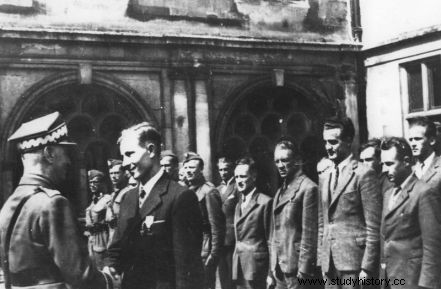"You are looking for death, come in for a moment" - such an inscription welcomed officers heading to the center where the best saboteurs and saboteurs in the history of Poland were trained. We reveal the secrets of their murderous training.
The most famous Cichociemni training center was established in June 1941 at Largo House near Leven in Scotland. Polish soldiers adapted the neglected palace park to their needs and within a few weeks transformed it into a real survival school. Ropes, ordinary and lowered trapezoids, swings were hung between the old, sprawling trees. All these instruments were supposed to get used to being in the air - says Kacper Śledziński in the book Cichociemni. The elite of Polish diversion ”. 
Each elevation had to survive the adventure with the "death trapezoid" in which a soldier is said to have died. Everyone fought their fear of heights, got used to the gusts of wind in flight, and instilled in themselves the right way of landing. Anyway, this method - developed by the Polish officer Lucjan Gębołys - turned out to be a real revolution and allowed fourteen times (sic!) To reduce the number of injuries among paratroopers.
Despite the popularization of this innovation on the Cichociemni Islands, they had to cope with basically no British support. They learned the basics of landing thanks to the illegally cut hole in the ceiling of the confiscated stable. All training devices were assembled on a private initiative and with private funds. Thanks to this, more and more time sessions could be spent in the "Monkey Grove" - as the park in Largo House was called - more and more time.
They not only prepared for the jumps, but also performed the jumps themselves. From the first parachute tower in Great Britain, from balloons, from planes. In addition, there were daily runs of 10 kilometers (before breakfast!) And constant competitive exercises:crawling under barbed wire, hand-to-hand combat training, and even pole vaulting.

Cichociemni training camp (fragment of the illustration in the book by Kacper Śledziński entitled "Cichociemni. The elita of Polish diversion").
All this physical training was just an introduction to real training, anyway. Carefully selected candidates became Cichociemni only thanks to courses organized at Special Training Stations, such as those at Briggens and Audley End.
There, young daredevils learned to carry out subversive and sabotage actions, learned the methods of working in the underground, learned the basics of introducing and reading codes, and also trained in the field of radio telegraphy and intelligence. During special lectures, they were also presented with the realities of life in occupied Poland, which they were supposed to know perfectly well before they got behind enemy lines.
The culmination of the training were simulated attempts to acquire protected objects, such as factories or ammunition depots. They were guarded by the British gendarmerie, the army and the Home Guard, and the commanders of the Cichociemni always informed in advance on what day they would launch the training attack. Nevertheless, the missions ended with spectacular successes.

Władysław Sikorski visits the Cichociemni at the training center in Audley Park to decorate them with the Virtuti Militari orders.
After one of the successful sabotage actions - when several facades "blew up" the factory guarded by the Home Guard - the commandant of the training station number 38, where the Poles were trained, Lieutenant Colonel Evans, made a radio call with the conciliator on the spot. The man who was tasked with assessing the course of the mission. He asked him about the situation, to which he replied: The shots are still heard, but it seems that it is all over, because the shots are getting rarer. Evans was amazed: Who are they shooting at, all Poles are already having dinner
Cichociemni was also to prove to be equally effective in the fight against the Germans.
Source:
- Kacper Śledziński, Cichociemni. The elite of Polish diversion , Znak Publishing House, 2012.
The article was originally published in 2012 in the "Bestseller" bulletin distributed during the Book Fair in Krakow.
